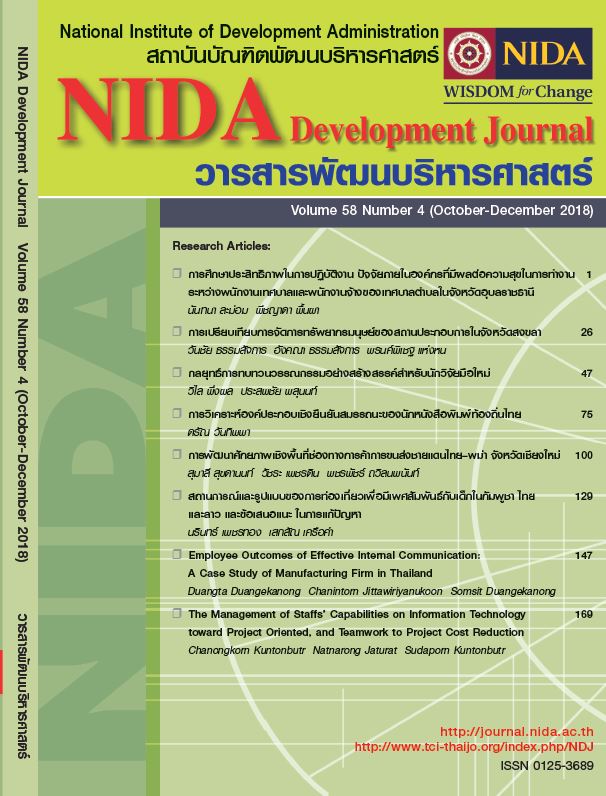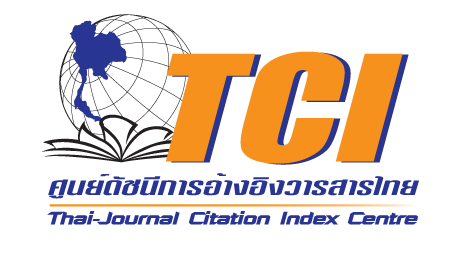Employee Outcomes of Effective Internal Communication: A Case Study of Manufacturing Firm in Thailand
Keywords:
Change resistan, internal communication quality, job satisfaction, organizational commitmentAbstract
The purpose of this research is to examine internal communication quality on employee outcomes including organizational commitment and job satisfaction in a manufacturing firm. Objectives include establishing a theoretical model of causes and consequences of internal communication. The study has been conducted as an online survey of employees within the organization, including managerial and non-managerial employees, with analysis conducted using structural equation modeling (SEM). The analysis shows that social acceptance of communication (appropriateness and acceptability) influenced perceptions of two dimensions of communication quality (flow and content). Perceptions of organizational communication structure, flow, content, and climate positively influenced internal communications quality perceptions, while employee resistance to change negatively influenced internal communications quality perceptions. The study also demonstrates that internal communications quality is thus positively associated with commitment and satisfaction while negatively associated with continuance commitment. The implication of this research is that internal communications research needs to examine employee characteristics more thoroughly.
References
Al-Hawary, S. I., Al-Qudah, K. A., Abutayeh, S. M., & Al-Zyadat, D. Y. (2013). The impact of internal marketing on emplyoee's job satisfaction of commercial banks in Jordan. Interdisciplinary Journal of Contemporary Research in Business, 4(9), 811-826.
Appelbaum, S. H., Louis, D., Makarenko, D., Saluja, J., Meleshko, O., & Kulbashian, S. (2013). Participation in decision making: A case study of job satisfaction and commitment (part one). Industrial and Commercial Training, 45(4), 222-229.
Byrne, B. M. (2016). Structural equation modeling with AMOS: Basic concepts, applications and programming. New York: Routledge.
Cheney, G., Christensen, L. T., Zorn, T. E., & Ganesh, S. (2010). Organizational communication in an age of globalization: Issues, reflections, practices (2nd ed.). Long Grove, IL: Waveland Press.
Feldner, S. B., & D'Urso, S. (2010). Threads of intersection and division: Joining an ongoing conversation within organizational communication research. Communication Research Trends, 29(1), 4-28.
Fowler, F. J. (2014). Survey research methods. (5th, Ed.) Thousand Oaks, CA: Sage Publications.
Frahm, J., & Brown, K. (2007). First steps: linking change communication to change receptivity. Journal of Organizational Change Management, 20(3), 370-387.
Gounaris, S. (2008). The notion of internal market orientation and employee job satisfaction: Some preliminary evidence. Journal of Services Marketing, 22(1), 68-90.
Graafland, J., Van de Ven, B., & Stoffele, N. (2003). Strategies and instruments for organising CSR by small and large businesses in the Netherlands. Journal of Business Ethics, 47(1), 45-60.
Gray, C., & Mabey, C. (2005). Management development: Key differences between small and large businesses in Europe. International Small Business Journal, 23(5), 467-485.
Hackman, J. R., & Oldham, G. R. (1980). Work redesign. Reading, MA: Addison-Wesley.
Huang, Y. -T., & Rundle-Thiele, S. (2014). The moderating effect of cultural congruence on the internal marketing practice and employee satisfaction relationship: An empirical examination of Australian and Taiwanese born tourism employees. Tourism Management, 42, 196-206.
Jacobs, M. A., Yu, W., & Chavez, R. (2016). The effect of internal communication and employee satisfaction on supply chain integration. International Journal of Production Economics, 171, 60-70.
Kassing, J. W. (2007). Going around the boss: Exploring the consequences of circumvention. Management Communication Quarterly, 21(1), 55-74.
Kline, R. B. (2011). Principles and practice of structural equation modeling. New York: Guilford Press.
Lammers, J. C., & Barbour, J. B. (2006). An institutional theory of organizational communication. Communication Theory, 16, 356-377.
Lewis, L. K. (2006). Employee perspectives on implementation communication as predictors of perceptions of success and resistance. Western Journal of Communication, 70(1), 23-46.
Mazzei, A. (2010). Promoting active communication behaviours through internal communication. Corporate Communications: An International Journal, 15(3), 221-234.
Men, L. R. (2014). Strategic internal communication: Transformational leadership, communication channels and employee satisfaction. Management Communication Quarterly, 28(2), 264-285.
Meyer, J. P., & Allen, N. J. (1991). A three-component conceptualization of organizational commitment. Human Resource Management Review, 1(1), 61-89.
Miller, K., & Barbour, J. (2015). Organizational communication: Approaches and processes (2nd ed.). Mason, OH: Cengage Learning.
Mumby, D. K. (2005). Theorizing resistance in organization studies: A dialectical approach. Management Communication Quarterly, 19(1), 19-44.
Robbins, S. P., & Judge, T. A. (2013). Organizational behavior (15th ed.). New York: Pearson.
Ruck, K., & Welch, M. (2012). Valuing internal communication: Management and employee perspectives. Public Relations Review, 38, 294-302.
Tsai, M. -C., Cheng, C. -C., & Chang, Y. -Y. (2010). Drivers of hospitality industry employees' job satisfaction, organizational commitment, and job performance. African Journal of Business Management, 4(18), 4118-4134.
Van Dijk, R., & Van Dick, R. (2009). Navigating organizational change: Change leaders, employee resistance and work-based identities. Journal of Change Management, 9(2), 143-163.
Van Riel, C. (1995). Principles of corporate communication. New York: Prentice Hall.
Van Riel, C. B., & Fombrun, C. J. (2007). Essentials of corporate communications: Implementing practices for effective reputation management. New York: Routledge.
Vercic, A. T., Vercic, D., & Sriramesh, K. (2012). Internal communication: Definition, parameters and the future. Public Relations Review, 38, 223-230.
Welch, M. (2012). Appropriateness and acceptability: Employee perspectives of internal communication. Public Relations Review, 38, 246-254.
Welch, M., & Jackson, P. R. (2007). Rethinking internal communication: A stakeholder approach. Corporate Communications: An International Journal, 12(2), 177-198.
Westland, J. C. (2010). Lower bounds on sample size in structural equation modeling. Electronic Commerce Research and Applications, 9(6), 476-487.





